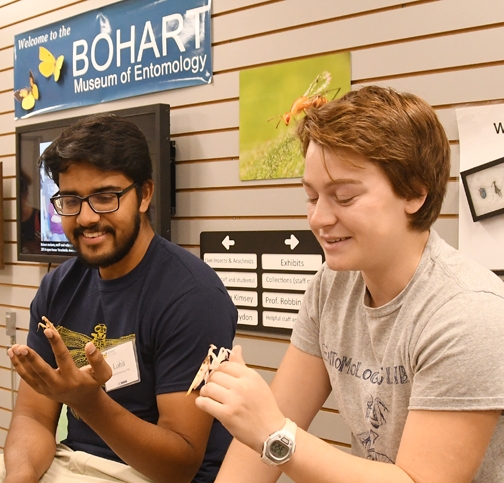
UC Davis entomology major Lohitashwa “Lohit” Garikipati, who will be displaying his praying mantis collection at the Bohart Museum of Entomology during the seventh annual UC Davis Biodiversity Museum Day on Saturday, Feb. 17, is keenly interested in sharing information about insects.
“Every organism on the Earth has value, and we should respect that,” says Garikipati, a third-year entomology student who rears praying mantises. “Regardless of its appearance, its lifestyle, or its behaviors, all the life that we see here on Earth is the result of change billions of years in the making. There's nothing that is scary, or disgusting; fear is taught, and the sooner we stop fearing and start appreciating, the sooner we can save as much biodiversity on the Earth as we can. It only takes one second to decide you care enough to stop fearing, so why not start now?”
Lohit (pronounced “Lo-Heat”) serves as secretary of the UC Davis Entomology Club, which is advised by forensic entomologist Robert Kimsey of the UC Davis Department of Entomology and Nematology.
“What I like most about mantids, besides their amazing appearance, is how charismatic they are compared to other insects,” says Lohit. “Their behavior varies between species, but all have this awareness that most other insects lack, which make them fun to interact with and study. Their predatory behavior is also interesting.”
Garikipati, a native of Pleasanton, Calif., says he's been interested in praying mantises since elementary school. “I started rearing native species in the 5th grade,” he recalled. “I kept a Mantis religiosa (European mantis) and hatched the ooths she laid. Since then I've had in my collection over a dozen species throughout that time. There wasn't any one species that I ended up consistently rearing, as I would get nymphs, rear them ‘til I got a second generation, then trade or sell them to get a new species. I will definitely be keeping orchids as long as I can though!”
Currently in his collection:
- Two adult female orchid mantises (Hymenopus coronatus)
- A pair of male and female adult Australian rainforest mantises (Hierodula majuscula)
- A pair of male and female 4th instar ghost mantises (Phyllocrania paradoxa)
- A 5th instar female African spiny flower mantis (Pseudocreobotra wahlbergii)
- Three third instar Decimiana bolivari (there's no agreed upon common name, but they can be called South American dead leaf mantises, he says).
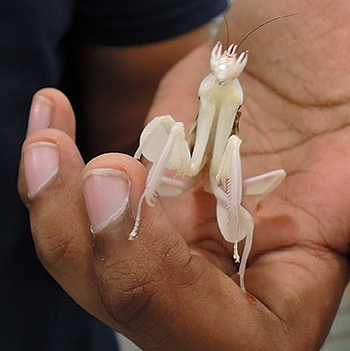
Lohit traces his interest in all insects to early childhood. “I've had an innate interest in animals in general as long as I can remember, insects just happened to be the most fun and most easy to find and study! The thing that fascinates me most about insects is their massive diversity and the ability insects have to surprise us by breaking what we think an animal can do. For example, wasps photosynthesizing.”
He is interested in enrolling in graduate school, “possibly in Davis--I'm not quite sure yet. Currently, my career plans involve doing research on mantis ecology, as well as updating taxonomy. Many genera need a lot of work and updated descriptions for the species they contain. I would like to be a professor as well!”
When he's not working with insects, Lohit enjoys “playing guitar, going to the gym, or trying to climb the mountain of homework or studying I have!”
Meanwhile, visitors can see learn all about praying mantises--and hold and photograph them--from 9 a.m. to 1 p.m., Feb. 17 at the Bohart Museum, located in Room 1124 of the Academic Surge Building, Crocker Lane. The Bohart, directed by entomology professor Lynn Kimsey, is the home of a global collection of nearly 8 million insect specimens, and a live "petting zoo," comprised of Madagascar hissing cockroaches, stick insects and tarantulas. Also on Feb. 17, highlights at the Bohart Museum will include the 500,000-specimen butterfly/moth collection, curated by entomologist Jeff Smith; and an insect collection display by Smith and fellow Bohart Museum associates Fran Keller and Dave Wyatt from their latest expedition to Belize. "You'll be able to see the tremendous diversity of butterflies, moths and mantids, and talk to the scientists who have just returned from there," said Tabatha Yang, education and outreach coordinator. "There will be orchids and orchid bees connecting the Bohart Museum's work with plant biology and science."
The Bohart Museum is one of the 13 museums or collections on campus where visitors can explore “the diversity of life” on Biodiversity Museum Day. All are within walking distance on campus except for the Häagen-Dazs Honey Bee Haven on Bee Biology Road and the Raptor Center on Old Davis Road. Set from 9 a.m. to 4 p.m., the event is free and open to the public. Parking is also free. Times will vary from 9 a.m. to 1 p.m., and from noon to 4 p.m..
The following will be open from 9 a.m. to 1 p.m.:
- Arboretum and Public Garden, Good Life Garden, next to the Robert Mondavi Wine and Food Science Institute, 392 Old Davis Road, on campus
- Bohart Museum of Entomology, Room 1124 of the Academic Surge Building, Crocker Lane
- California Raptor Center, 340 Equine Lane, off Old Davis Road
- Museum of Wildlife and Fish Biology, Room 1394, Academic Surge Building, Crocker Lane
- Paleontology Collection, Earth and Physical Sciences Building, 434 LaRue Road
- Phaff Yeast Culture Collection, Robert Mondavi Institute of Wine and Food Science, 392 Old Davis Road, on campus
- Viticulture and Enology Culture Collection, Robert Mondavi Institute of Wine and Food Science, 392 Old Davis Road, on campus
The following will be open from noon to 4 p.m.:
- Anthropology Museum, 328 Young Hall and grounds
- Design Museum, 124 Cruess Hall, off California Avenue
- Botanical Conservatory, Greenhouses along Kleiber Hall Drive
- Center for Plant Diversity, Sciences Laboratory Building, off Kleiber Hall Drive
- Häagen-Dazs Honey Bee Haven, Bee Biology Road, off Hopkins Road (take West Hutchison Drive to Hopkins)
- Nematode Collection, Sciences Laboratory Building, off Kleiber Hall Drive
All participating museums and collections have active education and outreach programs, Yang said, but the collections are not always accessible to the public. See capsule information about the museums and collections here. In the event of rain, alternative locations are planned for the outdoor sites. Maps, signs and guides will be available at all the collections, online, and on social media, including Facebook and Twitter, @BioDivDay.
Attached Images:
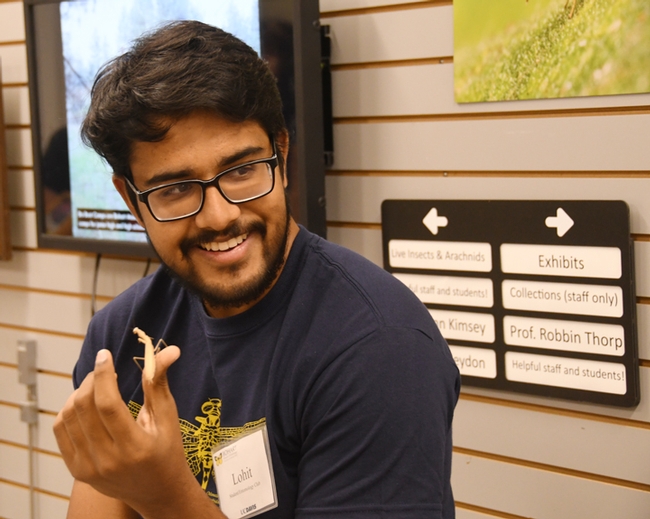
UC Davis entomology major Lohitashwa “Lohit” Garikipati showed his praying mantises at a Bohart Museum open house last September. He will be showing his collection on Saturday, Feb. 17 during the UC Davis Biodiversity Museum Day. (Photo by Kathy Keatley Garvey)
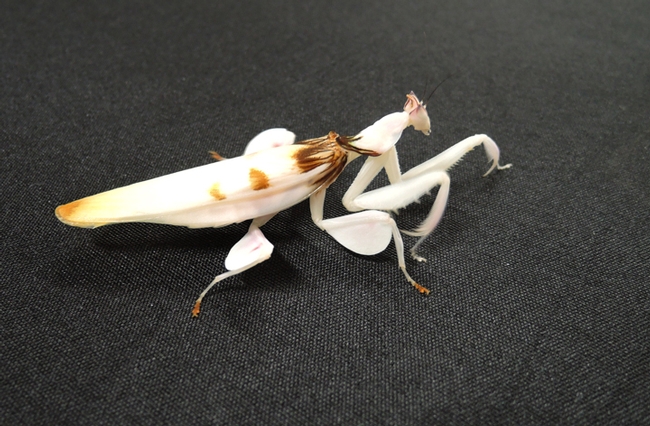
This is a close-up of an orchid mantis, Hymenopus coronatus, on the move. It is part of the collection of UC Davis entomology student Lohitashwa “Lohit” Garikipati, secretary of the UC Davis Entomology Club. (Photo by Kathy Keatley Garvey)
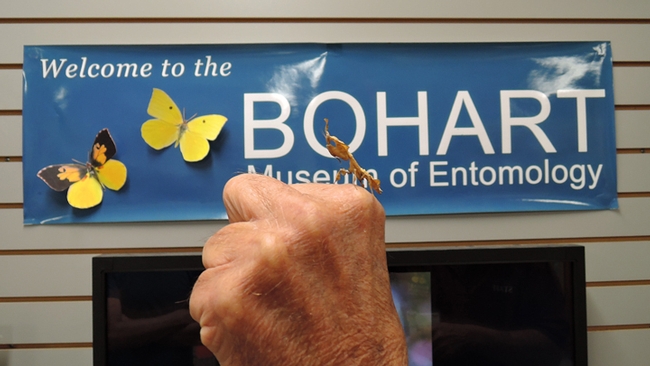
A praying mantis held next to the Bohart Museum of Entomology banner. (Photo by Kathy Keatley Garvey)